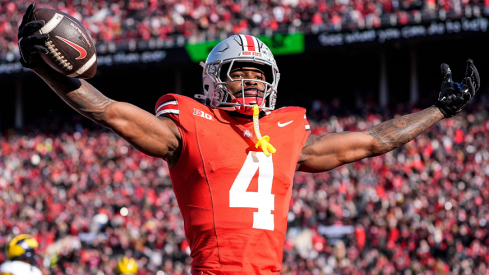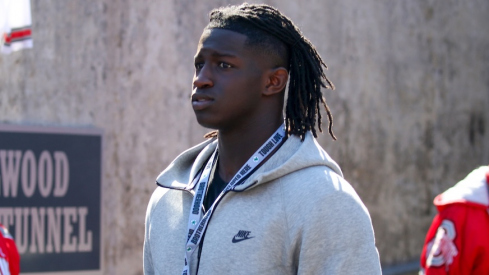
Ohio State continues to rack up yards and points—sometimes in spite of itself. Against Indiana, the Buckeyes' consistent run game and Braxton Miller's game-breaking ability overcame dropped passes and poor reads in the run game. If Ohio State can improve in these facets, they will become a difficult offense to stop. In the meantime, though, the Buckeyes have developed a one-two run game punch that consistently sustains and underlies most good offenses. With each game the Buckeyes implement a bit more of Urban Meyer's scheme, demonstrating the continued room to grow.
IU: One Man Advantage
Indiana generally presented Ohio State a 4-3 stack, cover 4 front. In other words, against the Buckeyes' 11 personnel (3 WR, 1 TE, 1 RB) the Hoosiers eschewed covering up the slot receiver to keep a seventh defender in the box against the Buckeye run game.

The Buckeyes were nonetheless largely able to run their base offense. One new emphasis was the first use of sweep read (though it does not appear that OSU is reading the one technique).
From there, OSU faked a similar action to run bootlegs.

Without a Hoosier defender covering the slot, this left medium-range completions to Jake Stoneburner and Philly Brown. Though OSU did leave easy yards on the field by not running wide receiver screens, they still took advantage of this play multiple times for easy completions.
From there, Ohio State faked this action to run a counter trey with Miller for a long touchdown run. This gave a different patina to the QB counter trey that has been a staple for the Buckeyes this year. It provided a constraint play with no added practice time for the offensive line, again demonstrating Meyer's penchant for making plays look alike within his base offense.
Ohio State also exhibited the 'touch pass,' a Dana Holgorsen favorite.
Tried and True
The Buckeyes did most of their damage, though, sticking to their base offense that has been so reliable this year—inside zone read, inverted veer and movement passes from those plays. The inside zone read play is the identity of the OSU offense. The Buckeyes likely run this play as frequently as all other plays combined. It provides the offense an identity and gives the personnel countless practice and game repetitions. As an added bonus, the play is particularly effective in short yardage. It hits the hole so quickly that it is difficult to stop. OSU can rely on their left side of their offensive line—a real strength—and hang their hat on the play. Here, Andrew Norwell creates leverage at the point of attack, Jack Mewhort releases onto the linebacker, and Carlos Hyde is able to quickly get to the second level.
OSU also has two running backs who are running with confidence. Hyde is demonstrating vision and a 'wiggle' that he has not heretofore shown, allowing him to make people miss at the second level. And Rod Smith is finally playing as many long expected. For instance, Smith used a textbook jump cut to move to the hole and then went north and south quickly.
Ohio State can then use Miller to attack the defense's edge with designed runs, reads and option plays. This week Ohio State successfully employed Miller running from the get-go, which opens everything else for the offense. On the opening drive, Miller perfectly executed two speed options back-to-back, keeping the first when the defender widened, and then pitching to Corey Brown for an untouched score.
This run-heavy plan is then supported by a heavy dose of bootleg and sprint-out passing. This reduces the field for Miller and puts him in a run-pass decision-making mindset. Miller again demonstrated improvement in the pass game, stepping in and delivering crisp throws.
As such, the Buckeye offense has a cohesive package from which they are effective. Miller's legs and an effective movement play-action game allow the Buckeyes to constrain the defense and protect their base inside run plays within a manageable package that fits the team's personnel. Thus, though the plays that OSU uses may be limited, they mesh together and complement each other, producing a multiplier effect. The Miller touchdown run above is a perfect example. It is a basic counter trey, gauzed up with a sweep fake and aided by the arithmetic advantage of running counter trey with the quarterback. The sweep fake prevents the defense from effectively keying in on Miller and widens the linebackers.
The upshot is that OSU is going to run inside read plays (itself constraint plays), lead plays to Miller, and then option and play-action from those run plays. As Meyer stated, the result may be that the Buckeyes are imbalanced, but they have rushed for over 300 yards the previous two outings and want to continue with what they do well. Though it is not fancy, it is a tried-and-true way to move the ball offensively and the most straightforward to execute. So long as an offense has an effective running game, it will rarely get behind the chains or have 'off' days. And that is particularly true when you can create explosive plays from the run game, as Miller regularly does.
The Only consistency is inconsistency
But, as has been true all year, Ohio State at times got in trouble when moving beyond this formula. For instance, in the third quarter up 31-17, Ohio State drove the ball on the ground to the Indiana 4. The Buckeyes then called back-to-back zone-read bootlegs to Miller's left, with the second leading to a poorly thrown interception. If Ohio State scores it may have put the game on ice.
More generally, Ohio State continues to stop itself with inconsistency in the read and passing game. Teams have to focus upon stopping Miller's running threat first and foremost. Read plays should put a defense in a Gordian knot. Yet Miller too often pre-determines his reads and/or makes the incorrect decision, leading to minimal yardage plays. The result is that the correct read generally results in positive yardage...
...but that Miller and the Buckeyes are leaving easy yards on the field.
The Buckeye passing offense is also not yet able to fully take advantage of teams committing additional defenders to stop the run. This game the most obvious example were two dropped passes by Devin Smith. Smith redeemed himself, including with a catch and run that the Buckeyes have not gotten this year from a receiver. The Buckeyes are also benefiting from the fact that Brown has developed into an extremely reliable receiver in the slot, to whom Miller and the Buckeyes look to on third down. OSU has thus developed a basic formula—work Brown underneath on option and pivot routes and then try to take the top off with Smith. Nonetheless, the Buckeyes are not yet an efficient enough passing team to make up for errors such as dropped passes.
The upshot is that the Buckeye offense is currently more consistent operating what they do well against defenses designed to take that away than they are taking advantage of what the defense is giving them.
'Go Make a Play'
The best thing Ohio State has, though, is that whenever the Buckeyes have needed a play this season Miller delivers one with his legs. Time and again Miller puts a close game out of reach with an explosive play, such as the counter trey above. Miller's ability means that this offense always has the potential to break the game open. And he has a knack for coming through with a big play at the right time. This should not be underestimated and is principally why Ohio State is undefeated.

